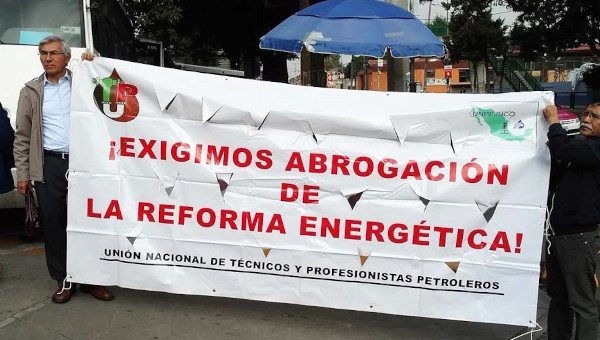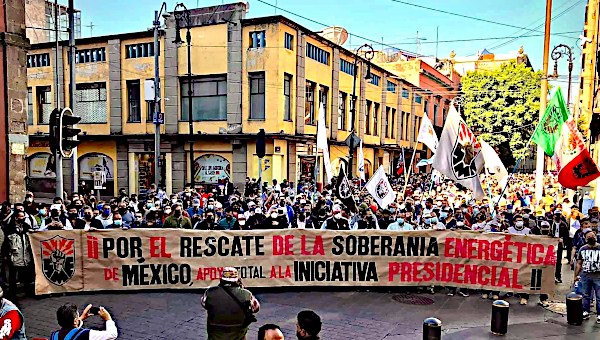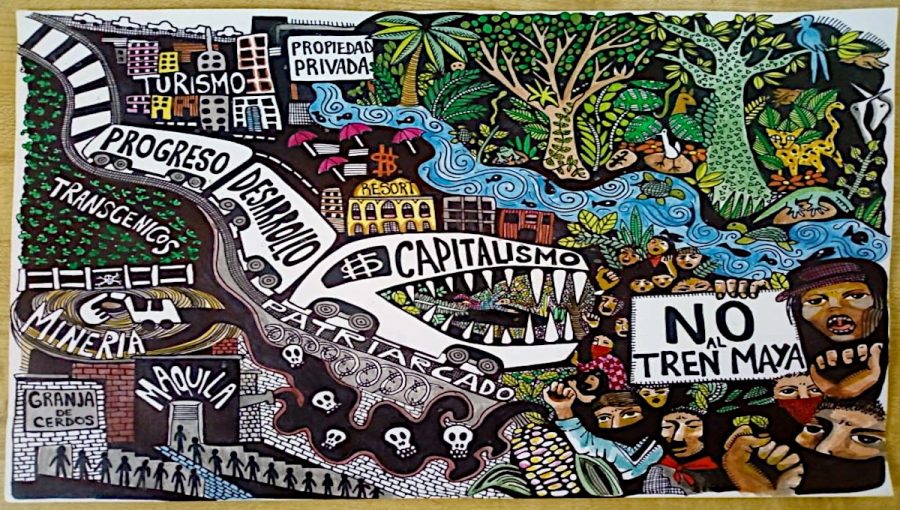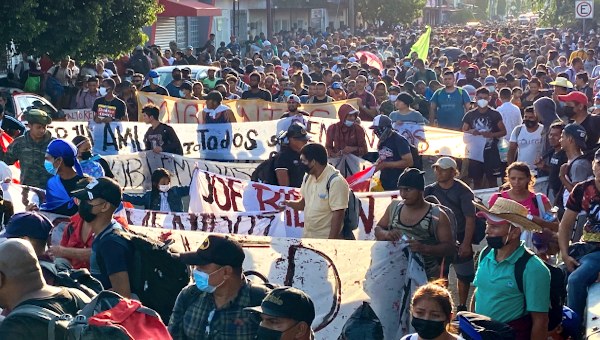Nearly two months ago, on September 26, a group of students from the Normal Rural Raúl Isidro Burgos – a boarding school for student teachers in Ayotzinapa, Guerrero – was soliciting funds in nearby Iguala when they were attacked by local police, acting under orders. Six people were killed; the remaining 43 students were arrested and were not heard from again. They have, for now, joined the ranks of Mexico’s disappeared.
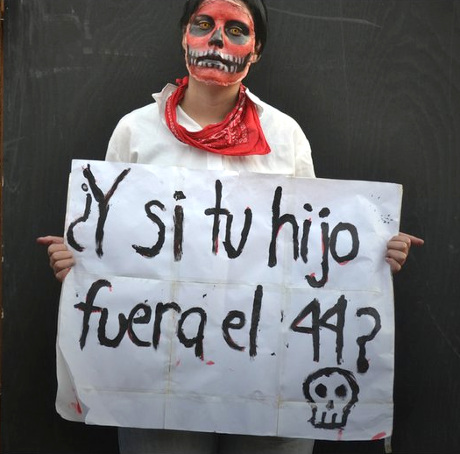
Common Sense and Reality
The oft-repeated common sense about how Mexico plunged into what has been variably termed ‘social decomposition’ or a ‘failed state’ goes like this:
The Institutional Revolutionary Party (known by its Spanish initials, PRI), which governed Mexico continuously from its founding in 1929 until 1997, had become a corrupt, increasingly nepotistic machine that nevertheless played by known rules. Under the PRI, drug cartels in the 1980s operated with the tacit acknowledgment and support of elected officials, so long as they didn’t get in the way or make things too messy. (The drug lords were, in that sense, just another group of robber-barons greasing the palms of the political authorities to smooth their business prospects.) This state of affairs began to collapse as a result of, first, the end of the ‘perfect dictatorship’: the PRI gradually lost control of various cities and states, then Congress (1997), and then the Presidency (2000), and so lost its ability to maintain social control; and second, of course, the pressure from the United States to embark on a heavily-militarized ‘war on drugs.’
The reality is, as always, more complicated (political economy is, unsurprisingly, left out of the commonsense account; but for the centrality – and bloodiness – of Mexico’s neoliberal turn, see again the excellent Bullet by Roman and Velasco.) But even the proponents of a war against the cartels surely knew from the outset that there was no obvious party to go about waging it – the cartels, the police, politicians, and the army were all deeply involved in each others’ business. This was such a poorly-kept secret that even insurgent groups in the 1990s took advantage of it. Guns were so regularly seized from drug gangs and then sold back to them that the Zapatistas figured, prior to their uprising, that nobody would notice if they started buying weapons directly from the police. (The police of course assumed they were a drug gang. The only hint that something was amiss was that the guns seemed to have been mysteriously taken out of circulation, rather than being seized in another bust.) When a new branch of law enforcement was indeed created in the late 1990s, the Federal Preventative Police (PFP), it displayed much more interest and prowess in counterinsurgency than in any attempt to curtail the cartels. The upshot of all this is that the anti-drugs crusade never functioned to do much more than direct a significant amount of new firepower and resources into destroying the fabric of Mexican society. It was deployed, predictably, against campesinos and the urban poor, and it had its beneficiaries as well.
Where were the political parties amidst all of this? One former opposition party, the right-wing National Action Party (PAN), desired principally to make the American Congress, foreign investors, and domestic capitalists happy; this fostered the apparent contradiction in Mexico that while labour and environmental regulatory laws are often quite strict – to appease the Capitol – their enforcement is often nonexistent, to appease capital. In any event, part of setting policy in lockstep with the United States included appearing to make Mexico a willing and able partner in the drug war. Meanwhile, most seasoned politicians of the Party of the Democratic Revolution (PRD) – for many years the hope of the social-democratic Left in Mexico, and whose militants included many young, left activists and intellectuals – were principally ex-PRI officials, mired in the same webs of corruption and nepotism as in the PRI. The PRD itself turned closer to the PRI after losing to the PAN (under questionable circumstances) in the presidential elections of 2000 and 2006. Both the mayor of Iguala and the governor of Guerrero were, incidentally, from the PRD.
Now that the PRI is back in office, some pundits blithely assumed that a lid would be put back on the killings, which were getting increasingly brazen and gruesome – but the opposite happened, and in the two years since Enrique Peña Nieto took office, the disappearances only accelerated. This should have been obvious: there is no possibility of restoring the mythical old order, even if it were desireable to do so. On one hand, an entire generation has now grown up in the new Mexico, and every young police officer, army recruit, and cartel lackey plays by the new set of rules, not the old ones. But on another, Mexico’s descent into its present nightmare has rather less to do with heroin traders’ turf wars than with accelerated dispossession and accumulation, with eating away at the egalitarian promises of the Revolution, and with the mass privatization of public and collective land and resources. We really have no idea how many massacres and disappearances were directly perpetrated by organized crime and which were perpetrated by the police and army; in some cases, including Iguala, it seems to be both. But at a more important level, it’s always both – and this is what the events of Iguala are bringing to light.
The Case of the Missing 43
So what makes this any different? What sets these 43 apart? Several factors seem to have been instrumental:
1. They were students, and they disappeared as a group, in police custody. (A representative of the UN Office on Forced Disappearances said that in his four years in the post he hadn’t heard of a single case of 43 disappeared in a single incident.) Further, the attack occurred metres from an army barracks – and when other students went looking for the missing immediately after their detention, this second group was detained by soldiers of the Mexican army’s 27th Infantry Batallion. Thus there has been a general sense that the military and federal police are involved very deeply and are simply using the investigation to cover their tracks. (As of this week, the general in charge of the 27th Infantry was promoted and will now oversee army operations in the entire region.)
2. There is an ongoing search, which has so far turned up numerous mass graves – none of which has been confirmed to contain the remains of the students, but rather contain the remains of dozens of other people who had been massacred then silently forgotten.
3. Following the arrest of Iguala’s mayor and several others, the Attorney General announced that thugs belonging to a local gang had confessed to killing the students and burning their bodies in a massive all-night fire, then dumping the remains; the fire supposedly burned so long and so hot that positive identification may be impossible. As if this wasn’t horrific enough, the entire event would, like the initial attack, have had to take place near the army barracks and right under the noses of the federal police as well, straining the credibility of anyone claiming that the federal authorities knew nothing about it. When pressed, the Attorney General abruptly cut off the press conference with the now-infamous statement-turned-hashtag “Enough. I’m tired” (#yamecanse) – which merely inflamed the movement. (“Ya me canse,” sometimes “ya me cansé,” seems to be the new “Ya basta.”)
4. They were normalistas – students from the escuelas normales – which gives these events a particular political character that might otherwise have remained
buried. Not only does it inflame the student movement, but an attack on normalistas also makes it very difficult to maintain the façade of responsibility that would tie all violence to a drug war and cartel rivalries (rather than to capital investment or to political repression, or the complex relation between all of them). In all prior cases, the government avoided shouldering any blame by passing the responsibility onto the victims: either they must have been involved in criminal activity, or lamentably they were just in the wrong place at the wrong time. Not this time.
Who Are the Normalistas?
Canada has no equivalent to the escuelas normales, which are teacher-training schools founded in the aftermath of the Mexican Revolution. The idea was to train young, idealistic Mexicans in a variety of skills who would then fan out to teach them to others in remote and rural areas. The normales continue to be predominantly rural, and many are boarding schools. Historically, they have also been explicitly socialist. Recent profiles in El País and La Jornada note that a typical student today is likely to be poor, militant, and radical, and political education has been as much part of the training as literacy or fieldwork (in this case meaning, literally, working in the fields). In the early years of post-revolutionary Mexico, all of this would have been an asset; with the ‘institutionalization’ of the revolution, and then the neoliberal turn, the normalistas could be more threatening. Xun Betan, a Tzotzil writer originally from Chiapas, recalled in La Jornada:
“My grandfather used to tell me stories about the first teachers who came to our village: they came from the Normales and they helped the community because they could be doctors, lawyers, engineers, and other activities, in addition to being teachers. They were conscientious people who also worked in the fields… Such young teachers were a threat to government strategies, and for this they were killed.”
Although there are normales all across Mexico, the Normal Rural Raúl Isidro Burgos has a particularly radical history: it educated many of the
guerrillas of the 1960s, including the famed leader of the Party of the Poor, Lucio Cabañas, who was a student leader there prior to waging the insurgency. Yet recent federal education reforms have threatened the normales and the traditions of
training and service that they represent. Students have had to solicit funds for their own schools’ operations whenever travelling, and it was on one such trip, passing through Iguala en route to Mexico City, that the 43 were disappeared.
¡Vivos se los Llevaron, Vivos los Queremos!
(They Took Them Alive, We Want Them Back Alive)
There is a general sense in Mexico both that unrest is growing and that the Mexican state has long since stopped exercising anything resembling hegemony. As roads are blocked daily in various parts of the country, sometimes including the capital, protestors remind inconvenienced
passersby that it is not they who have caused the breakdown of order; the narcostate did that a long time ago. Students are on strike at
many campuses, and teachers have gone on strike at thousands of schools controlled by one of the more radical teachers’ unions. There are growing calls for a general strike. Dozens of city halls have been seized. Some states, such as the usual suspects of Guerrero,
Michoacan, Chiapas, and the D.F., have seen more demonstrations and blockades than others, but the protests are spreading, with some taking place even in the usually-remote Baja peninsula (the missing 43 resonate deeply in every region with normales). The teachers’ organizations behind some actions tend to be socialist; many university students are anarchists.
November 20 marked the 104th anniversary of the Mexican Revolution, and the movement successfully turned it into an International Day of Action for Ayotzinapa, with hundreds of thousands taking part. La Jornada called it one of the “largest demonstrations of recent years” as marches, strikes, and other protests were held simultaneously in
dozens of cities across Mexico, and solidarity demonstrations took place across the world. In Mexico City, President Peña Nieto abruptly cancelled the military parade and festivities that were scheduled to take place in the Zócalo, basically handing the square to the demonstrators as three marches from different parts of the city, each led by a different group of family members of the 43 students, were scheduled to converge on the Zócalo. Instead of presiding over a military parade, the President was burned in effigy.
The moral leadership of the Ayotzinapa movement comes from the parents of the disappeared, who caravaned around the country last week in search of support, keeping the narrative focused on the state, not letting anyone shift the blame onto their children, and keeping up the demand
that the students be returned alive. Significantly, one of their first stops was in Chiapas, where they sought (and received) the blessing of the Zapatista leadership for their campaign. One student from Ayotzinapa who accompanied the caravan insisted that it had become necessary “to build a movement from below, as the Zapatistas did in 1994, in order to remove the [obstinate] structures of the Mexican government… We began this caravan in [Zapatista] territory to make clear our message of rage and dignity to the politicians and to tell them ya basta at all these injustices, promises, and so much shit; ya basta to legal government, we want legitimate governments in which we can trust. This trip is in
order to bring a message to the Mexican state and all its corrupt institutions: that we no longer believe in them…”
Where Is This Headed?
As protests continue to grow, there are at least three scenarios on the visible horizon: two are pessimistic, but the third, though more difficult to achieve, is by no means out of the question. It’s important to remember that although the Mexican state controls most (though not all) of the use of force in the country, its control of Mexican society is far from hegemonic. Rather than a momentary blip,
this is the result of a fairly steady erosion for twenty years. This expands the horizon of possibility, but it may also make the Mexican state – and those using it to protect their own interests – more dangerous.
Scenario 1: Political shake-ups
None of the three major parties are going to have a role in improving the situation, at least not in the immediate future. PRD founder Cuahtémoc Cárdenas this week called on the entire leadership of the PRD to resign for its disgraceful role in the Iguala affair, but he
was rebuffed by an obstinate party president. Neither the PRI nor the PAN have any incentive to take action other than to put window-dressing on the matter and re-orient themselves even more
strongly toward the external business and investment community. However, some sort of political shake-up may be likely, if for no other reason than that resignations and the fingering of individuals to shoulder systemic blame are the closest thing we have to a scripted response to sustained protests.
What next? To paraphrase the Zapatistas’ Subcomandante Moisés last week, to change the faces and even the etiquette is far from sufficient.
The ‘political class’ doesn’t feel it needs to appease everyone; it just needs to make it appear that it’s doing something, in order to take some momentum out of the movement. Currently all the momentum is in the protestors’ favour, and the government is looking to take the wind out of its sails.
Scenario 2: Open repression and return to the ‘dirty war’
This possibility is the most ominous, but becoming more likely. Demonstrations are becoming more polarized, particularly in Guerrero – with regular protests and blockages by normalistas and their
supporters, and the Acapulco business community asking on at least one occasion for the intervention of the army. The army responded at the time that it wouldn’t intervene, because the civil police have not yet been declared incompetent, and it doesn’t want to create more
violence. But it must have loved being asked. On Friday, the U.S. embassy warned Americans to stay away from Acapulco. (Canada, as of this writing, still regards Mexico in its entirety to be a ‘safe’ country.)
During the two decades of the ‘guerra sucia,’ government forces massacred student protestors and coordinated the extralegal torture and murder of leftists and suspected guerrillas. In important respects, the ‘dirty war’ never really went away – it just became more diffuse and covered up as the guerrillas were defeated,
neoliberalism introduced, and Mexico tried to attract international investment (and eventually free trade with the U.S. and Canada).
Neoliberal restructuring was not possible without systematic dispossession, and it was precisely the ‘dirty war’ playbook that political and military figures looked to when they created new paramilitary groups to wage counterinsurgency campaigns
in Chiapas and Guerrero against suspected rebel sympathizers and human rights campaigners, and tried to pay off others. Certainly repression continues to be the lived reality in many parts of Mexico. Yet there are some important differences as well, and a real and
palpable fear of a surge of more blatant political repression throughout the country. There is a generation of political activists in Mexico who came of age during the Zapatista uprising in the 1990s, as student activists, as Zapatista supporters, as feminists, labour
organizers, environmental activists, democracy campaigners, most of whom really were operating in a safer political climate than that of their parents. But that’s slipping away.
The spark could easily be the violent repression of a demonstration: it would look apparently spontaneous, a situation in which the army is called in as a ‘last resort’ to restore order and the rule
of law. The state would of course cite the ‘increasingly violent’ protests, but may also cite the events of Iguala and the need for a ‘firmer hand’ against the drug cartels.
Either way it will only happen after the army has been publicly seen turning down requests to intervene on more than one occasion. And it will be made to appear that there’s a groundswell of support for repressive measures.
Both the President and cabinet ministers have addressed the case of Iguala and/or the unrest, but denied that there is anything yet resembling a humanitarian crisis in Mexico. (It’s unclear who the intended audience is of this line – I suspect it’s not internal.) Speaking
more clearly to a domestic audience after returning from China last week, the President warned that he hopes he “won’t have to use force” against the protestors, and on Thursday the Secretary of Labour said the government had “reached the limits of its patience” with demonstrations, and may have to take unspecified action to curtail them. (Predictably, he used violent demonstrations
as a pretext – although the irony of his claim, “violence can’t be fought with more violence, and so in this case the government must act,” seems to have been lost on him.)
The protestors of course understand that violence will be the pretext for repression, which is why most of the movement is bending over backward to insist that its protests remain nonviolent. The question of violence, certainly against people, in most of the demonstrations is not even being debated so much as simply proscribed. Destructive acts against property have targeted government or party property, and even some of these have been disowned by the protestors themselves, claiming they are the work of provocateurs. (Although these provocateurs are being referred to as “encapuchados” – literally, “the masked ones” – masking is somewhat complicated in Mexican social movements: it remains the public face of Zapatismo, which predates the Black Blocs, and it’s common for activists to wear masks when blocking roads or occupying offices, radio stations, and town halls separately from the mass demonstrations. In such situations, the individuals often protect their identities but the groups are known and take responsibility. This past week, for example, masked activists from the Guerrero union of education workers, the CETEG, took over and occupied the Attorney General’s headquarters in Chilpancingo. Mass protests are a different kind of action, however, and organizers of the 20 November rallies asked that no one be masked except the normalistas themselves.) In most instances, the Mexican press continues to refer to the movement and most of its actions as “peaceful,” and even goes to some lengths, more than might be expected in Canada or the U.S., to distinguish between mass protest and a few broken windows. The distinction, however, may not prove meaningful: what grabbed the headlines after the 20 November mass demonstration in the Zócalo wasn’t the protest itself but the subsequent clash between masked individuals with molotov cocktails and militarized riot police, who eventually cleared the square and arrested 31 protestors as they did so. An unknown number of people were injured.
Whether the ‘encapuchados’ were hired by the government to infiltrate the march, as a senator from the Workers’ Party (PT) claimed over the weekend, or are dissident activists, is somewhat beside the point, for whomever they are, they appear to be essential to the government’s strategy for dealing with the movement as a whole. The public security chief for the capital defended the use of force in a statement that carefully distinguished between protestors and encapuchados, saying the latter group were not students but (amid a litany of characterizations we’ve all heard before) professional thugs without jobs who hate authority. By his account, they infiltrated a (legitimate) protest in order to kill people. Those detained, whether or not they were indeed part of the group lighting things on fire, have since been termed ‘terrorists’ and affiliates of organized crime, and are facing extremely serious charges. Freeing those detained on November 20 has become a new rallying point for the movement.
A cynic would argue – and Mexican history, I think, gives one a warrant for cynicism – that accepting a differentiation between protesters and provocateurs was a shrewd move by the security forces, which are setting themselves up to be seen on the one hand balking at repressing a legitimate movement, yet on the other ready to intervene to save lives. It allows protests to come to be understood as places where violence takes place, without having to challenge the moral authority of the protestors themselves. Much may depend on whether they can collapse the entire category of the ‘encapuchado’ into the ‘terrorist’ (as they tried but failed to do with the Zapatistas). As far as the President and his cabinet are concerned, road blockages, occupations, and work stoppages are more disruptive than molotov cocktails, and the latter will simply be the excuse to put an end to the former.
Scenario 3: Revolutionary change
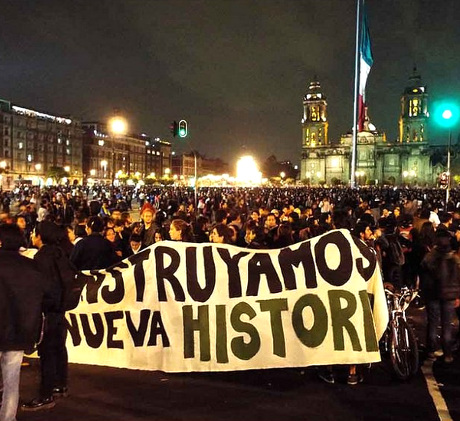
also being thrown around in a variety of contexts, but it doesn’t seem to imply armed struggle, at least for now.) Article 39 of the current Constitution, which makes the vague promise that all sovereignty resides in the Mexican people, offers legal backing for such an initiative.
The difficulty lies in getting from here to there.
Most movements have demands, but the limits of a movement that makes demands are most apparent when they are coupled with a withdrawal of trust and legitimacy from precisely those institutions of which one is making demands. The Ayotzinapa movement, of course, is in this
position. It has four demands often repeated in slogans, hashtags, speeches, and op-eds, and at most two of them are practical in the sense that they’re within the realm of possibility of things that can
conceivably be granted: (1) The return of the students alive; and (2) The resignation of President Enrique Peña Nieto.
Although technically demands of the state, these are really expressions of the movement. The first indeed reflects a sliver of hope – until their bodies are positively identified, we will consider them alive and missing. But more than that: it produces a narrative of responsibility for the crime. As for the second, Peña Nieto could resign. But then what? The point here is that the President is a target of the movement’s anger, and nobody trusts him. If this was achieved, one hopes it would invigorate the movement rather than cause it to consider its mission accomplished.
The other two principal demands are not apparently achievable demands at all, even though they are framed as such: (3) Justice for the disappeared; and (4) An end to conditions that make these heinous crimes possible.
For some protestors, demands like these may indicate little more than outrage and protest; and when movements coalesce around such demands (insisting that the state do x or y, whether or not that is structurally possible), they can easily lose momentum, get co-opted, and fizzle out.
However, I want to suggest that the demands of the Ayotzinapa movement may be of another type – something much more in the tradition of the
Zapatistas’ lengthy list of demands for liberty, justice, land, democracy, equality, peace, dignity, etc. The whole point of the EZLN issuing these demands was that they could in no way be fulfilled within capitalism or by the state as it is. The issuance of
unachievable demands thus demonstrated the limits of neoliberal politics and provided, for the Zapatistas, the ultimate justification for autonomy.
“Calls are growing for a constituent assembly and for the protests to be understood first and foremost as the legitimate exercise of popular sovereignty, the first step in rebuilding Mexico from the bottom up.”
Yet, how a politics of demands-that-are-not-demands operates nationally poses a unique set of problems that have yet to be worked out. Within the movement there is not yet a program of social transformation or governance to replace the corrupt and bloody institutions, no counter-hegemony or program is at the ready. Autonomy made sense for Zapatista communities in part because there was no obvious solution on a national scale. In Zapatista territory, where Zapatismo was – and is – hegemonic, autonomy also made experimentation possible. But the crisis spawned by Iguala, and the movement led by the students and families of Ayotzinapa, will have to find its resolution across the country as a whole. This is why the calls are growing for a constituent assembly and for the protests to be understood first and foremost as the legitimate exercise of popular sovereignty, the first step in rebuilding Mexico from the bottom up.
What these demands, and the movement as a whole, will ultimately morph into is anybody’s guess. There are models, however: the experiences of Venezuela, Bolivia, Greece, and Spain are each an imperfect fit with the Mexican case, but nevertheless demonstrate that movements born of protest and anger at an entire array of political institutions can indeed become a transformative, even revolutionary, force.
At the moment there is mostly anger – indignación – but that anger is helping to draw together the pieces of the mess that the ‘political class’ (to use the demonstrators’ terminology) tried so long to keep separate. People are angry about the 43 students, but not only about them. Through them, they see tens of thousands of people who were not victims of random, regrettable violence, but were targets of a narco-capitalist state and its projects of dispossession and repression. That recognition is enough for there to be hope, and it’s why this won’t go away anytime soon. •
Thanks to Greg Albo, Fabiola Berdiel, Barbara Epstein, Eloy Rivas Sanchez, and Susan Spronk for their comments on a draft of this piece.


